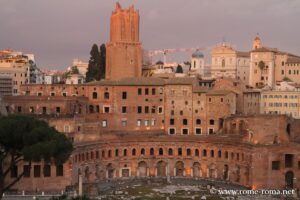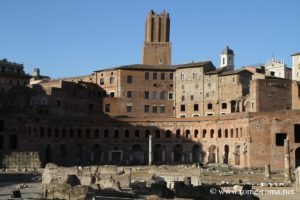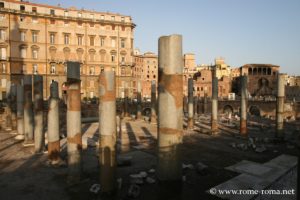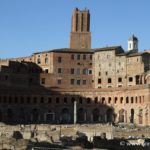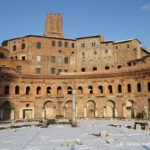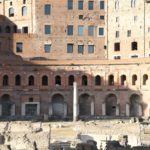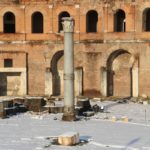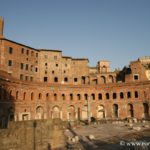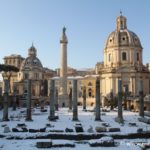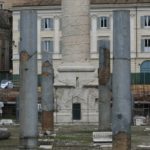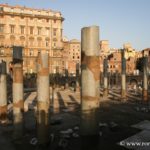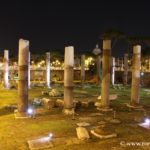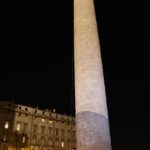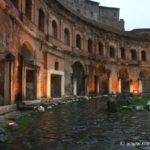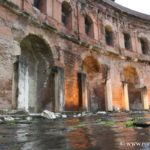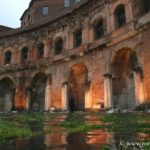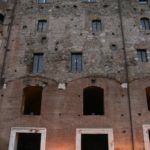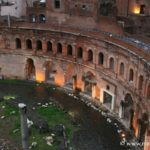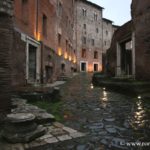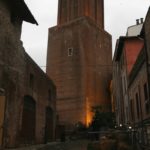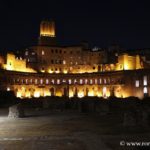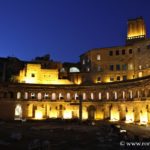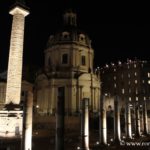Built at the beginning of the 2nd century by Emperor Trajan and the architect Apollodorus of Damascus, the complex completed the sequence of the Imperial Fora and pushed the technical limits of Roman urban planning: part of the neighboring hill was leveled to create a vast 300-meter-wide esplanade with porticoes.
Main Features of the Forum
The last of the imperial forums to be constructed, the Forum of Trajan was also the most impressive of its time. At its center stood the Basilica Ulpia, of Marcus Ulpius Traianus, measuring 170 x 60 meters, the largest basilica built in Rome, with two libraries (one Greek and one Latin), and the Column of Trajan (dedicated in 113), bearing the sculpted narrative of the Dacian Wars. The base of the column also carries the inscription “a declarandum quantae altitudinis mons e locus tantis operibus sit egestus” (To indicate how high the hill was that was removed for these works).
Around its perimeter, the structures known as the Markets of Trajan today form the Museum of the Imperial Forums, where some of the site’s decorative architectural fragments are displayed. Open since November 2007, it often hosts temporary exhibitions. Recent interventions have reopened pathways and initiated partial reconstructions, while also conducting new excavations and discoveries.
Notable Points:
- The layout of the Basilica Ulpia and the partial reconstruction of its colonnade
- The Column of Trajan (dedicated in 113) with its Dacian campaign scenes, clearly visible with binoculars
- Experimental pedestrian routes around the former Via Alessandrina, reconnecting the various excavation blocks
- The panoramic terrace of the Markets, offering an overview of the stratigraphy of the Forums
Historical Overview and Original Appearance
The Forum of Trajan was begun in 107 CE, the year of Trajan’s triumph over the Dacians (in present-day Romania), and completed in 113 CE.
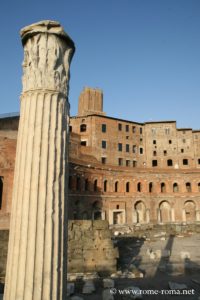 Designed to enlarge the monumental core after Caesar, Augustus, Vespasian, and Nerva, it is organized around a monumental square, 300 by 185 meters, on elevated terraces, bordered by porticoes and dominated by a bronze equestrian statue of Trajan. This statue stood at the center of the vast square, about 3.5 meters high, with Trajan on horseback holding a lance pointed downward, symbolizing peace.
Designed to enlarge the monumental core after Caesar, Augustus, Vespasian, and Nerva, it is organized around a monumental square, 300 by 185 meters, on elevated terraces, bordered by porticoes and dominated by a bronze equestrian statue of Trajan. This statue stood at the center of the vast square, about 3.5 meters high, with Trajan on horseback holding a lance pointed downward, symbolizing peace.
At the southeast entrance of the square, a large triumphal arch was surmounted by a statue of Trajan on a chariot drawn by six horses, accompanied by trophies and victories.
Two sides closed by colonnaded gates were intended to display statues of previous emperors and their families.
The Basilica Ulpia closed the perspective to the north. Its interior was divided into 5 naves separated by four rows of columns and also took over the role of the previously destroyed Atrium Libertatis, behind which stood the two libraries flanking the Column. The complex served both triumphant propaganda (victories in Dacia) and administrative, judicial, and economic functions.
The terrace buildings attached to the escarpment, long interpreted as “markets,” mainly housed offices and service areas of the imperial administration; however, they still retain tabernae opening onto internal streets. Recent works have focused on the architectural reading of the decor (orders, entablatures, friezes), reconstructed at the Museum of the Markets of Trajan.
Construction required the leveling of the hill between the Capitoline and the Quirinal. This led to the destruction of the Atrium Libertatis, the former administrative and cultural center of Rome, some of whose functions were transferred to the Basilica Ulpia. A portion of the Servian Walls, now obsolete, was also removed to clear the necessary space.
Visiting the Forum Ruins
The site is generally explored from Via dei Fori Imperiali (freely accessible), descending toward Trajan’s esplanade; the axis of the Basilica Ulpia is easily identified by the column bases and, further north, the area of the Column with its helical relief (original in place; copies and surveys in the museum).
Recently established routes (some within the Museum of the Markets) allow visitors to approach the eastern porticoes and appreciate the reconstructed volumes (columns, entablatures).
To the east, the terrace structures of the Markets of Trajan host the Museo dei Fori Imperiali, essential for understanding the ornamentation: capitals, figurative friezes, reconstructed cornices, explanatory panels, and models. It also provides elevated views of all the Imperial Forums and contextualizes the fragments by their original forum (Augustus, Nerva, Trajan). Educational installations and temporary exhibitions are regularly programmed here.
Recent Developments and Excavations
Since 2023, a partial reconstruction of the colonnade of the Basilica Ulpia has been presented to the public as part of a program to stabilize and reinterpret the esplanade; pedestrian pathways are gradually being installed to reconnect the cleared areas around Via Alessandrina. A project for a pedestrian belt around the Imperial Forums is also under study.
Regarding excavation news, campaigns near Via Alessandrina in 2025 uncovered a colossal marble head from Trajan’s Forum square.
Photo gallery
- View on the forum and the markets of Trajan
- View of Trajan’s forum and markets
- View of Trajan’s forum and markets
- View of Trajan’s forum and markets
- View of Trajan’s forum and markets
- Remains of the forum
- Remains of the forum
- Trajan’s Column
- Trajan’s Market
- Trajan’s Market
- Trajan’s Market
- Trajan’s Market
- Trajan’s Market
- Trajan’s Market
- Trajan’s Market
- Torre delle Milizie
Map and address
Address : Via dei Fori Imperiali, 00186 Roma RM, ItalieIf you see this after your page is loaded completely, leafletJS files are missing.
Ancient views in art
Information
| Trajan’s Forum Via dei Fori Imperiali, 00186 Rome |
Trajan’s Market Museum
|
Links
|
Articles on the Trajan Forum
- Trajan’s Market Museum
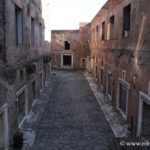 The very interesting Museum of the Imperial Forums – Trajan’s Markets (Mercati di Traiano Museo dei Fori Imperiali) is topographically ...
The very interesting Museum of the Imperial Forums – Trajan’s Markets (Mercati di Traiano Museo dei Fori Imperiali) is topographically ... - Trajan’s Column
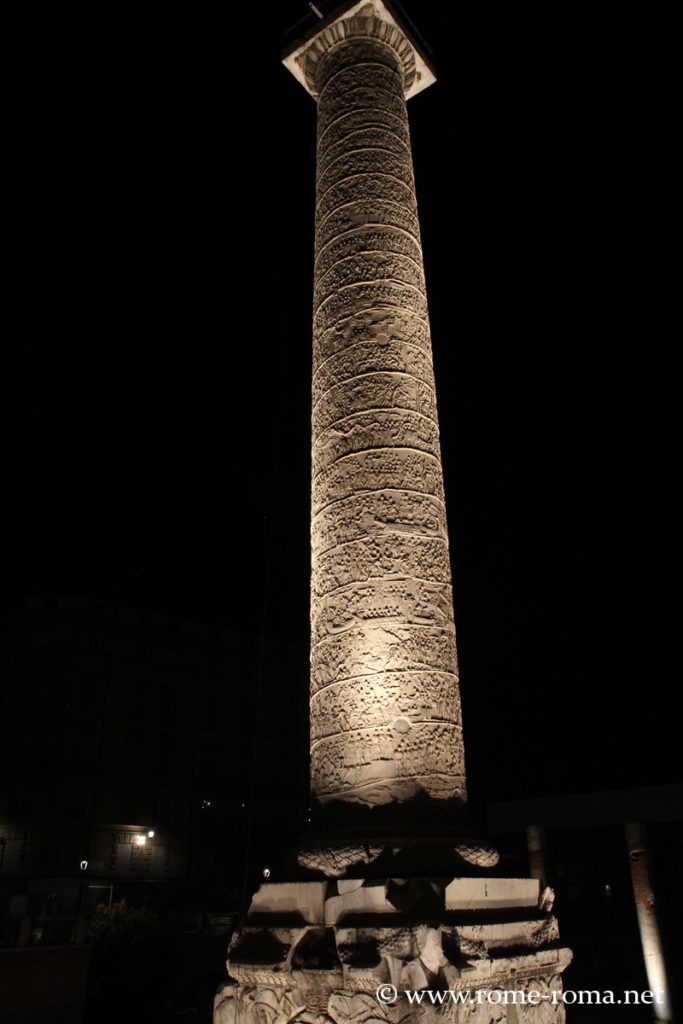 The reliefs of the Trajan’s column in Rome recount the emperor’s military campaigns against the Dacians. High by about 30 ...
The reliefs of the Trajan’s column in Rome recount the emperor’s military campaigns against the Dacians. High by about 30 ...
The Imperial Fora places
- Imperial Fora, a monumental ensemble
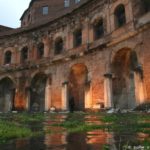 The Imperial Fora, today crossed by the avenue of Via dei Fori Imperiali, which covers a large portion of this ...
The Imperial Fora, today crossed by the avenue of Via dei Fori Imperiali, which covers a large portion of this ...

